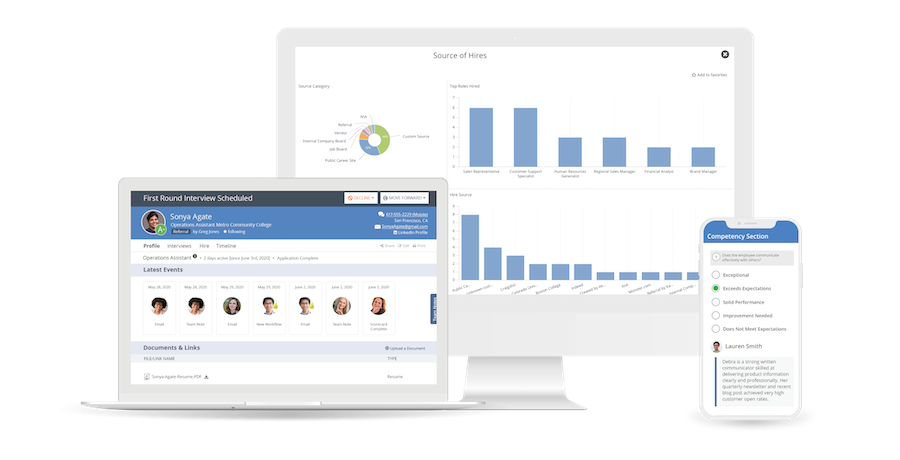This article on goal alignment and employee engagement was originally published in February 2014. All relevant information and copy have since been updated as of February 2021.
Recent studies have found that an astonishing 85% of employees are disengaged from their work. With such low engagement rates within organizations, companies face increasing costs at work due to lower productivity and higher turnover rates. To engage and attract your employees’ attention, you need to ensure your goals and strategies are aligned across your organization’s levels.
Ensuring your talent is aligned with company goals is an important part of organizational success. Understanding goals and individual contributions can make the difference between a checked-out workforce and a motivated employee pool. As you analyze your own organization’s strategic goal alignment, these 12 questions will help provide insight into the effectiveness of your efforts.
85% of employees are disengaged from their work. How can leaders help to align the #goals of their team and engage their staff? @ClearCompany has 11 tips for you:1. What is Goal Alignment?
Goal alignment, or strategic alignment, is the process by which you keep your workforce working towards your company's overarching goals. When company-wide goals are set, steps must be taken to ensure that employees are informed about what they should be working on and why. Managers must ensure that their individual goals and the goals of their direct reports are in line with the overarching strategy. Proper strategic goal alignment ensures the work of your best talent is effectively and efficiently utilized.
Bonus Material: Check out our tips for creating challenging yet achievable goals for your employees.
2. Why is Goal Alignment in Performance Management Critical?
When your people understand their goals and how they align with their teams and leaders’ goals, you can ensure that everyone in your company is collaborating on the right projects at the right time. A well-aligned organization fosters a system that ensures the right people are working on the right things. Understanding how an individual employee’s work affects the larger organizational goals allows for an in-depth understanding of progress. Additionally, it ensures your workers understand their value and contributions to the company.
Through proper goal alignment, your employees see greater clarity in their expectations and responsibilities and are more highly motivated to achieve their goals. This helps improve employee engagement and leads to happier company culture. Implementing a goal-centric system makes certain your people are working towards the right goals, preventing costly misalignment.
Bonus Material: Are you struggling with how to motivate and engage your remote staff? Check out these 4 strategies for improving engagement in your organization.
3. What’s Real-Time Goal Tracking?
The best companies ensure they have the tools and support in place to facilitate real-time tracking and feedback. Real-time tracking enables organizations to see the status of projects and allows leaders the chance to provide feedback or critiques where necessary. Real-time feedback opens the door for actionable change and addresses issues before they become problems. By implementing a system that allows you to tag projects, tasks, and meetings to goals, you can see what your employees are working on and how that work helps you meet company goals. This increases transparency in work and communication throughout your organization.
Bonus Material: Ensure your feedback is valuable with our step-by-step guide.
4. How Does Goal Alignment Increase Transparency?
Organizational transparency is crucial if you want to maintain an engaged workforce. Tying an employee’s daily tasks to the overall goals they are expected to accomplish will show them why their work matters. Employees can easily get caught up in the day-to-day routine of their work and become disengaged. In fact, only 15% of employees are actively engaged in their work. Thanks to talent alignment platforms, your team can have daily check-ins on company strategy and visualize how their efforts contribute to the whole organization.
Tip: Use employee engagement surveys to gauge the sentiment of your employees. These quick surveys can help provide insight into the happiness and well-being of your employees.
5. How Does Goal Alignment Help With Recruiting?
If your recruiting team truly understands your company goals, you will attract and retain more highly qualified hires. Knowing what tasks your candidate will perform helps you identify the specific skills new hires will need on the job. This knowledge will allow you to write more highly-tailored job descriptions and will ensure you ask the questions that matter during the interview period.
Bonus Material: Ensure your job descriptions are compliant with our checklist.
6. How Does Goal Alignment Ease Onboarding?
When it is clear how a new hire will contribute to company goals and progress, you can communicate these expectations more effectively during the onboarding process. Strategic alignment will help your new hires visualize why their work matters and how it plays into your team’s greater goals. They can hit the ground running as soon as they step foot in your company, thanks to increased organizational transparency.
Tip: Ditch the paper trail and embrace a digital and paperless onboarding system with ClearCompany.
7. Can Goal Alignment Cut Down on Office Politics?
Office politics can easily harm your hard-won employee engagement. No one benefits from the gossip that often stems from a lack of understanding of workflow and performance. Thankfully, both transparency and goal alignment can cut down on needless office politics. Easy visualization means you can see everyone’s contributions to your organization, so you’ll always be sure to reward and recognize the right people.
Bonus Material: Does your organization have a strong and reliable recognition strategy? Check out these 3 recognition programs you can implement today.
8. How Does Proper Alignment Prevent Goal Decomposition?
Consistently communicating goals and tracking them in real-time can keep work from cascading in the wrong direction. The average organization can end up playing something akin to a game of Telephone, with messages and directives flying wildly off course. Visualizing progress, strategic alignment, and tracking goals can keep work on track. You can make sure that your goals are being worked towards and keep them from decomposing in the hierarchies of your organizational chart. Holding one another accountable will increase communication and engagement levels downstream.
Bonus Material: See how SMART goals can help you to create more focused and powerful performance goals in 2021.
9. Can Goal Alignment Increase Productivity?
Transparency and alignment make employees on every level accountable for their progress and performance. Increased accountability, in turn, increases productivity while connecting their work back to goals and can inspire employees to take ownership of their work. Productivity is increased when workers understand why their contributions matter and what value they add to the organization.
Bonus Material: See how you can transform employee productivity through proper goal-setting.
10. How Does Goal Alignment Improve Employee Engagement?
Tying daily work to overall company goals can help employees understand their role, see how their work matters, and become more motivated to add value to the organization. When employees see their contributions at work, they are more likely to feel like a valued part of the team, increasing employee engagement. Since employee engagement is tied to better corporate outcomes, it's crucial your team feels valued and involved.
Bonus Material: Follow these tips to help supercharge employee engagement within your organization.
11. Does Goal Alignment Improve Corporate Communication?
Being able to visualize workflow and see how work connects to goals can easily improve corporate communication. Instead of only using quarterly or annual reviews, feedback can be exchanged daily for a specific project or task. Consistent touchpoints like this can help correct small mistakes before they snowball into long-term performance problems.
Tip: Use technology to increase communication between teams. Video conferencing tools and chat sites will help enhance transparency and help support communication among remote teams.
12. How Can I Clearly Communicate Company Goals?
Goal alignment in your company is crucial to create a culture of engagement and productivity. By providing clarity in responsibilities and expectations, your employees will feel more connected to their work and more engaged with their projects. You can use performance management software to share company goals and set individual goals, making it easy to tie them to larger company goals. Goal transparency helps everyone understand where they fit in, how their colleagues are contributing, and what's necessary for success.
ClearCompany has a history of helping leaders take charge of their performance management strategy. With our fully integrated Performance Management Suite, organizations can ensure their strategies and visions are aligned across all levels. To find out more about our performance management capabilities, reach out to one of our experts.

.png)
